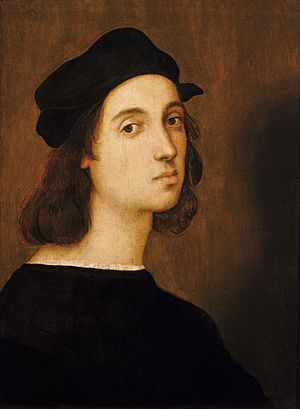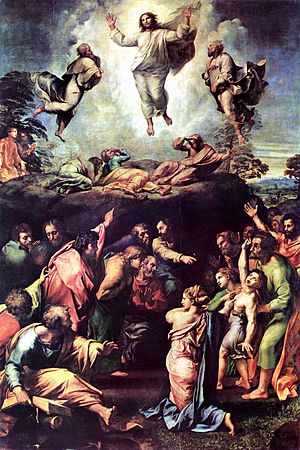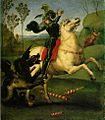Raphael facts for kids
Quick facts for kids
Raphael
|
|
|---|---|

Self-portrait by Raphael
|
|
| Born |
Raffaello Santi (or Sanzio)
March 28 or April 6, 1483 Urbino, Duchy of Urbino
|
| Died | April 6, 1520 (aged 37) |
| Resting place | The Pantheon, Rome |
| Known for | |
| Movement | Renaissance |
Raffaello Sanzio, known as Raphael, was a famous Renaissance painter and architect. He was born on April 6, 1483, and died on April 6, 1520.
Raphael is one of the three greatest painters of the High Renaissance. The other two are Leonardo da Vinci and Michelangelo. He is especially famous for his paintings of the Madonna (Mary, the mother of Jesus) and the Christ Child. He also created many amazing paintings in the Vatican in Rome, Italy.
Contents
Raphael's Early Life in Perugia
Raphael was born in Urbino, a town in the Umbria region of Italy. His father, Giovanni Santi, was also a painter. Sadly, Raphael's mother died when he was only eight years old. His father died when Raphael was eleven.
When Raphael was about 15, he became an apprentice in the workshop of a painter named Pietro Perugino. Perugino was the most famous painter in the town of Perugia. He was also well-known in Rome and Florence.
Perugino was one of the artists who painted the Pope's large chapel in the Vatican, called the Sistine Chapel. He was known for his excellent painting skills and for finishing his work on time. This made him very popular with his patrons (people who paid him for art).
Raphael learned a lot from Perugino. He learned how to draw, how to paint human figures, and how to mix and apply paints smoothly. Perugino's paintings often showed people with sweet, gentle faces. Many of Raphael's early paintings also have this gentle style. Raphael was very good at painting, and people loved his artwork.
Raphael's First Paintings
One of Raphael's earliest known paintings is a small picture called The Vision of a Knight. It tells a story through symbols (an allegorical painting). In the painting, a knight is sleeping. In his dream, two beautiful women appear. One woman offers him flowers, and the other offers a sword and a book. This painting makes you think about choices: should the knight choose a path of love or a path of duty?
Other early works by Raphael include Three Graces and Saint Michael.
Raphael's first big painting was The Marriage of the Virgin, painted in 1504. This painting was inspired by a work Perugino did for the Sistine Chapel. Today, The Marriage of the Virgin is in the Brera Gallery in Milan, Italy.
Raphael in Florence
Around 1504, Raphael traveled to Florence, Italy, with another painter named Pinturicchio. Florence was famous for its art, its artist workshops, and its beautiful new Renaissance buildings. Raphael wanted to see the work of great artists like Michelangelo and Leonardo da Vinci.
The Madonnas
Florence was a city that loved images of the Madonna and Child (Mary and baby Jesus). The city was dedicated to the Blessed Virgin Mary. You could find paintings or statues of the Madonna and Child on almost every street corner.
While in Florence, Raphael painted many of his most famous Madonna paintings. Some of these well-known works include:
- The Madonna of the Goldfinch (around 1505), which is in the Uffizi Gallery in Florence.
- The Madonna del Prato (around 1505), found in the Kunsthistorisches Museum in Vienna, Austria.
- The Esterházy Madonna (around 1505–1507), located in the Museum of Fine Arts in Budapest, Hungary.
- La Belle Jardinière (The Madonna of the Beautiful Garden) (around 1507), which is in the Louvre Museum in Paris, France.
Raphael's Time in Rome
In 1508, Pope Julius II invited Raphael to Rome. Raphael became so popular there that people called him the "Prince of Painters." He spent the last 12 years of his life in Rome, creating many of his most famous artworks.
While in Rome, Raphael was asked to paint a fresco (a painting on wet plaster) of the prophet Isaiah in the Church of Sant'Agostino. While working, he visited his friend, the architect Donato Bramante. Bramante was at the Vatican while Michelangelo was painting the Sistine Chapel ceiling. Raphael wanted to see Michelangelo's work. When Michelangelo was away, Bramante took Raphael into the Chapel. Raphael was so amazed by Michelangelo's paintings of the prophets that he went back to Sant'Agostino's Church, scraped his own painting of Isaiah off the wall, and started over! Raphael was not ashamed to be influenced by such a great artist.
The Stanze: Vatican Rooms
Some of Raphael's most famous paintings are the frescos on the walls of Pope Julius II's own rooms in the Vatican Palace. These rooms are known as the Stanze. Raphael painted the frescos in the Stanza della Segnatura and the Stanza d'Eliodoro himself. He designed the Stanza dell'Incendio, and his assistants painted it.
The School of Athens is the most famous fresco in the Stanze della Segnatura. It shows a group of wise people from Ancient Greece, including philosophers, poets, and mathematicians. They are listening to the central figure, the philosopher Plato. This painting shows that in the early 1500s, Rome was experiencing a new burst of ideas and learning, just like Ancient Athens.
To make this message clear, Raphael used the faces of people he knew. The figure of Plato with long hair and a beard is a portrait of Leonardo da Vinci. It is believed that Michelangelo, with his broken nose, is shown sitting with paper and ink. Raphael even included himself in the painting, standing near the back on the right side.
One amazing thing about this painting is how Raphael painted the building around the figures. The architecture looks so real, as if it's an extension of the room itself.
Raphael as an Architect
In the 1500s, painters were often asked to design buildings. Raphael's first architectural project was a funeral chapel in the church of Santa Maria del Popolo. Pope Leo X also chose Raphael to help design St. Peter's Basilica with Donato Bramante.
After Bramante died, Raphael took over the design of the basilica. He changed its groundplan (the shape of the building from above) from a Greek cross to a Latin Cross. Later, Michelangelo went back to Bramante's original plan, but made it simpler. Another architect, Maderna, eventually made the building longer, as Raphael had planned.

The Transfiguration
Raphael's last artwork was a painting called The Transfiguration. This was meant to be an altarpiece (a painting placed above an altar in a church). Sadly, Raphael died before he could finish it. His assistant, Giulio Romano, completed the painting.
Raphael's Death
Raphael died on his 37th birthday. He was buried in the Pantheon in Rome. His funeral was held at the Vatican, and his unfinished Transfiguration altarpiece was placed at the head of his funeral carriage.
Interesting Facts About Raphael
- Raphael had a tough childhood: his mother died when he was nine, and his father died when he was eleven. His brothers and sisters also died young.
- He became one of the best painters in his hometown.
- In Rome, he was in friendly competition with two other famous artists: Leonardo da Vinci and Michelangelo.
- Raphael was engaged to be married but never actually married his fiancé.
- He was considered one of the most important architects in Rome.
- Raphael was known for being charming and friendly. People believe his good personality helped him get many important art jobs.
- When planning his large artworks, he made many sketches and drawings first.
Other pages
Images for kids
-
Giovanni Santi, Raphael's father; Christ supported by two angels, c.1490
-
Guidobaldo da Montefeltro, Duke of Urbino from 1482–1508, c.1507
-
The Madonna of the Pinks, c. 1506–7, National Gallery, London
-
The Miraculous Draught of Fishes, 1515, one of the seven remaining Raphael Cartoons for tapestries for the Sistine Chapel
-
Raphael and Maria Bibbiena's tomb in the Pantheon. The Madonna is by Lorenzetto.
-
The Mond Crucifixion, 1502–3, very much in the style of Perugino
-
Il Spasimo 1517, brings a new degree of expressiveness to his art
-
Self-portrait, Raphael in the background, from The School of Athens
See also
 In Spanish: Rafael Sanzio para niños
In Spanish: Rafael Sanzio para niños










































